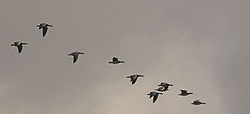
Migration is the usually seasonal movement of animals in pursuit of food, suitable breeding sites or to escape bad weather or other environmental conditions. Mass migrations create some of the world’s greatest wildlife spectacles. Birds have a streamlined body shape and a lightweight skeleton that is adapted for migration and composed of hollow bones that minimize air resistance and reduce the amount of energy necessary to become airborne. The birds have well-developed pectoral muscles, which are attached to a uniquely avian structure called the furculum, power the flapping motion of the wings. The long feathers of the wings of birds act as airfoils which help generate the lift necessary for flight.
Birds have large, four-chambered hearts that proportionately weighs 6 times more than a human heart. This, with a much faster and rapid heartbeat(the hummingbird beats 1000 times per minute), satisfies the rigorous metabolic demands of flight. Unlike reptilian lungs, the birds have lungs that remain inflated at all times, with air sacs throughout the body that act as bellows to provide the lungs with constant supplies of fresh air.
Flight affords mobility and has made possible the evolution of avian migration as a means of access to distant food resources. It also can mean avoiding the physiological stress associated with cold weather. There are many variations in the patterns of migration. Some travel thousands of miles while some move up slopes and down them.

There are bad side effects of migration: predation and bad weather are two natural causes of mortality during migration. There are collisions with tall buildings, windows, and other structures, being shot, trapped by hunters, and even struck by cars. Many birds cannot determine the difference between the real sky and the reflection of the sky in the window.
There are four main types of migratory birds, and they can be distinguished into four types:
There are four main types of migratory birds, and they can be distinguished into four types:
- Permanent residents, or just "residents," are non-migrating birds such as House Sparrows who remain in their home area all year round.
- Summer residents are migratory birds such as Purple Martins who arrive in our Northern backyards in the spring, nest during the summer, and return south to wintering grounds in the fall.
- Winter residents are migratory birds who have "come south" for the winter toour backyards. White-throated Sparrows, who are summer residents in much of Canada, are winter residents in much of the U.S.
- Transients are migratory species who nest farther north than our neighborhoods, but who winter farther south; thus we see them only during migration, when they are "just passing through."